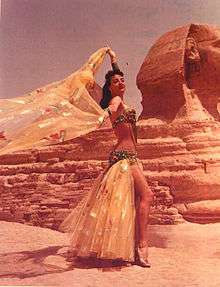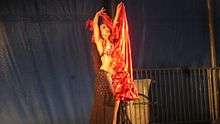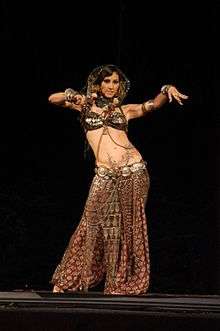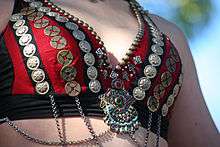Belly dance

Belly dance is an expressive dance which emphasizes complex movements of the torso.[1] Originally a Middle Eastern folk dance, it has evolved to take many different forms depending on the country and region, both in costume and dance style. New styles have evolved in the West as its popularity has spread globally.
Names and terminology
The term "belly dance" is a translation of the French term "danse du ventre", which was applied to the dance in the Victorian era, and probably originally referred to dancers from the Ouled Nail tribes of Algeria. It is something of a misnomer, as their dance used more abdominal movements than the dances described today as "belly dance".
In Arabic, the dance is known as Raqs Sharqi ("Eastern Dance") or Raqs Beledi("Country Dance" or "Folk Dance").

Belly dance is primarily a torso-driven dance, with an emphasis on articulations of the hips.[2] Unlike many Western dance forms, the focus of the dance is on isolations of the torso muscles, rather than on movements of the limbs through space. Although some of these isolations appear similar to the isolations used in jazz ballet, they are sometimes driven differently and have a different feeling or emphasis.
In common with most folk dances, there is no universal naming scheme for belly dance movements. Some dancers and dance schools have developed their own naming schemes, but none of these is universally recognised.

Movements found in belly dance
Many of the movements characteristic of belly dance can be grouped into the following categories:[3]
- Percussive movements - Staccato movements, most commonly of the hips, used to punctuate the music or accent a beat. Typical movements in this group include hip drops, vertical hip rocks, outwards hip hits, hip lifts and hip twists. Percussive movements using other parts of the body can include lifts or drops of the ribcage and shoulder accents.
- Fluid movements - Flowing, sinuous movements in which the body is in continuous motion, used to interpret melodic lines and lyrical sections in the music, or modulated to express complex instrumental improvisations. These movements require a great deal of abdominal muscle control. Typical movements include horizontal and vertical figures of 8 or infinity loops with the hips, horizontal or tilting hip circles, and undulations of the hips and abdomen. These basic shapes may be varied, combined and embellished to create an infinite variety of complex, textured movements.
- Shimmies, shivers and vibrations – Small, fast, continuous movements of the hips or ribcage, which create an impression of texture and depth of movement. Shimmies are commonly layered over other movements, and are often used to interpret rolls on the or riq or fast strumming of the oud or qanun (instrument). There are many types of shimmy, varying in size and method of generation. Some common shimmies include relaxed, up and down hip shimmies, straight-legged knee-driven shimmies, fast, tiny hip vibrations, twisting hip shimmies, bouncing 'earthquake' shimmies, and relaxed shoulder or ribcage shimmies.
In addition to these torso movements, dancers in many styles will use level changes, travelling steps, turns and spins. The arms are used to frame and accentuate movements of the hips, for dramatic gestures, and to create beautiful lines and shapes with the body, particularly in the more balletic, Westernised styles. Other movements may be used as occasional accents, such as low kicks and arabesques, backbends, and head tosses.
Belly dance in the Middle East
Origins and history of belly dance in the Middle East
Belly dancing is believed to have had a long history in the Middle East, but reliable evidence about its origins is scarce, and accounts of its history are often highly speculative.[4] Several Greek and Roman sources including Juvenal and Martial describe dancers from Asia Minor and Spain using undulating movements, playing castanets, and sinking to the floor with 'quivering thighs', descriptions that are certainly suggestive of the movements that we today associate with belly dance.[5] Later, particularly in the 18th and 19th centuries, European travellers in the Middle East such as Edward Lane and Flaubert wrote extensively of the dancers they saw there, including the Awalim and Ghawazee of Egypt.[6] In the Ottoman Empire belly dance was performed by both boys and women in the Sultan's palace.[7]

Social context of belly dance in the Middle East
Belly dance in the Middle East has two distinct social contexts: as a folk or social dance, and as a performance art.
As a social dance, belly dance (also called Raqs Baladi or Raqs Shaabi in this context) is performed at celebrations and social gatherings by ordinary people (male and female, young and old), in their ordinary clothes.[8] In more conservative or traditional societies, these events may be gender segregated, with separate parties where men and women dance separately.[9]
Historically, professional dance performers were the Awalim (primarily musicians and poets), Ghawazi and Köçekler. The Maazin sisters may have been the last authentic performers of Ghawazi dance in Egypt, with Khayreyya Maazin still teaching and performing as of 2009.[10]
In the modern era, professional performers (including dancers, singers and actors) are not considered to be respectable in the Middle East, and there is a strong social stigma attached to female performers in particular, since they display their bodies in public, which is considered haram in Islam.[11]
Belly dance in Egypt
Working in Cairo are some of the most famous bellydancers, costume designers, and talented musicians.
The modern Egyptian belly dance style (and the modern costume) are often said to have originated at the cabaret of Badia Masabni but this is disputed. Certainly, many of her dancers went on to appear in Egyptian films and had a great influence on the development of the Egyptian style.[12]
Egyptian belly dance is noted for its controlled, precise movements. Floor work and forward thrusts of the hips are not permitted in Egypt. Terms that are often used to describe the Egyptian style of dance is solo, elegant, smooth, internalized movement, controlled, flows, graceful, full of emotion.[13]
Belly dance in Turkey
Turkish belly dance is referred to in Turkey as Oryantal Dans, or simply 'Oryantal'. The Turkish style of bellydance is lively and playful, with a greater outward projection of energy than the more contained Egyptian style. Turkish dancers are known for their energetic, athletic (even gymnastic) style, and their adept use of finger cymbals, also known as zils. Connoisseurs of Turkish dance often say a dancer who cannot play the zils is not an accomplished dancer. Floorwork, which has been banned in Egypt since the mid-20th century, is still an important part of Turkish bellydance.
Another distinguishing element of Turkish style is the use of a 9/8 rhythm, counted as 12-34-56-789, often referred to as Karsilama rhythm. Karşilama, in Turkish dance, is not a rhythm but a folkdance performed in a line, where as a 9/8 (dokuz sekiz) rhythm defines the count of the rhythm and is used both karşilama and Roman havasi.
Many professional dancers and musicians in Turkey continue to be of Romani heritage, and the Roma people of Turkey have had a strong influence on the Turkish style[14] (There is also a distinct Turkish Romani dance style which is different from Turkish Oriental). Music in Turkish style dance is very similar to Armenian and Greek music. It is very fast paced and energetic like the dance. Some terms that can be used to describe Turkish style dance: flamboyant, floorwork, romany havasi (influence), zils, pelvic movement, athletic, and energetic.[15]
Belly dance in Lebanon
Lebanese style belly dance is somewhere between the Egyptian and Turkish styles. Lebanese dance takes from the classic oriental dance, but still incorporates a fiesty, modern edge. There are large steps, backward leans to the torso, twisting hip rotatations, large and busy arms and lots of shimmies. The types of techniques that are used in Lebanese style dance are quick layered shimmies and subtle internal movements. Lebanese dancers sometimes include kicks, splits, deep back bends, and Turkish drops.[16]
Belly dance outside the Middle East
Belly dance was popularized in the West during the Romantic movement of the 18th and 19th centuries, when Orientalist artists depicted romanticized images of harem life in the Ottoman Empire.
Belly dance in North America

Although there were dancers of this type at the 1876 Centennial in Philadelphia, it was not until the 1893 Chicago World's Fair that it gained national attention. The term "belly dancing" is generally credited to Sol Bloom, the entertainment director of that event, although he consistently referred to the dance as danse du ventre, (of which "belly dance" is a literal translation). In his memoirs, Bloom states, "when the public learned...danse du ventre...I had a gold mine."
Authentic dancers from several Middle Eastern and North African countries performed at the Fair, including Syria, Turkey and Algeria—but it was the dancers in the Egyptian Theater of The Street in the Cairo exhibit who gained the most notoriety. The fact that the dancers were uncorseted and gyrated their hips was shocking to Victorian sensibilities. There were no soloists, but it is claimed that a dancer nicknamed Little Egypt stole the show. Some claim the dancer was Farida Mazar Spyropoulos, but this fact is disputed.[17]
The popularity of these dancers subsequently spawned dozens of imitators, many of whom claimed to be from the original troupe. Victorian society continued to be affronted by the dance, and dancers were sometimes arrested and fined.[18] The dance was nicknamed the "Hoochie coochie", or the shimmy and shake. A short film, "Fatima's Dance", was widely distributed in the Nickelodeon theaters. It drew criticism for its "immodest" dancing, and was eventually censored. Belly dance drew men in droves to burlesque theaters, and to carnival and circus lots.
Thomas Edison made several films of dancers in the 1890s. These included a Turkish dance, and Crissie Sheridan in 1897,[19] and Princess Rajah from 1904,[20] which features a dancer playing zills, doing "floor work", and balancing a chair in her teeth.
Ruth St. Denis also used Middle Eastern-inspired dance in D. W. Griffith's silent film Intolerance, her goal being to lift dance to a respectable art form at a time when dancers were considered to be women of loose morals. Hollywood began producing films such as The Sheik, Cleopatra, and Salomé, to capitalize on Western fantasies of the orient.
When immigrants from Arab States began to arrive in New York in the 1930s, dancers started to perform in nightclubs and restaurants. In the late 1960s and early '70s many dancers began teaching. Middle Eastern or Eastern bands took dancers with them on tour, which helped spark interest in the dance.
Although using traditional Turkish and Egyptian movements, American Cabaret or American Restaurant belly dancing has developed its own distinctive style, using props and encouraging audience interaction. Many modern American dancers also make use of the music of Egyptian Sha'abi singers in their routines.
In 1987, a distinctively American style of group improvisational dance, American Tribal Style Belly Dance, (ATS), was created. Although a unique and wholly modern style, its steps are based on existing dance techniques, including those from North India, the Middle East, and Africa.[21] Many forms of "Tribal Fusion" belly dance have also developed, incorporating elements from many other dance and music styles including flamenco, ballet, burlesque, hula hoop and even hip hop. "Gothic Belly Dance" is a style which incorporates elements from Goth subculture.
Belly dance in Spain
Belly Dance was in Spain much earlier than the majority of people think, the first Belly Dancers came from Lebanon in the times of the Phoenicians from the 11th Century B.C. until 5th Century B.C. . When the Arab family of the Umayyad came to Spain, they saw that it was a beautiful country, and called it Al Andalus. The meaning of the name is highly contested. The Arabs brought back their new knowledge, their new religion, and their art. They discovered that the spanish women from the north of Spain, in the area known as Basque country, were very successful singers and dancers. From then they started to get students from the Basque, and brought them to Damascus and Egypt to train them to be great dancers in Al Andalus. Those dancers came to be known as Al Andalus dancers. The Arabs known more by the spaniards in a despective way, as The Moorish, stayed in Spain from the year 711 until their expulsion in 1609. Just before their expulsion, the Al Andalus dance started to fuse with the Gypsies. This led to the creation of, after few centuries of fusing both dances, a new form of dance known as Flamenco.
Belly Dance didn't come back to Spain until the 1980's, with the end of the Catholic regime of Franco. The first Belly Dancers to be named performing in Spain in the 1980's are: Sahar Samara (Alia Shams), the sisters Samah and Laila Rangel, Gloria Alba, Teresa Rambha, then afterwards in the late 80's the first Belly Dance schools in Spain were Las Pirámides by the egyptian male teacher Shokry Mohamed in the year 1990 in Madrid, Academia de Danzas Árabes by Alia Shams in the year 1994 in Seville, the first one in Andalusia El Karnak was founded in 1995 in Madrid. From the early 90's the first students from these first Belly Dance teachers and Schools started to appear. Dancers and teachers like the Amora Shams daughter and student of Alia Shams and Helena Rull the student of Teresa Niembro. Both of whom are still currently teaching, and entered the new century helping to start the boom of Belly Dance in Spain. All the new schools and dancers developed from these original dance teachers and schools.
Belly dance in Australia

The first wave of interest for belly dancing in Australia was during the late 1970s to 1980s with the influx of migrants and refugees escaping troubles in the Middle East, including drummer Jamal Zraika. These immigrants created a lively social scene including numerous Lebanese and Turkish restaurants, providing employment for belly dancers. Rozeta Ahalyea is widely regarded as the "mother" of Australian belly dance, training early dance pioneers such as Amera Eid and Terezka Drnzik. Belly dance has now spread across the country, with vibrant belly dance communities in every capital city and many regional centres.
Belly dance in the United Kingdom
Belly dance has been in evidence in the UK since the early 1960s. During the 1970s and 1980s, there was a thriving Arabic club scene in London, with live Arabic music and bellydancing a regular feature,[22] but the last of these closed in the early 1990s.[23] Several prominent members of the British bellydance community began their dance careers working in these clubs.
Today, there are fewer traditional venues for Arabic dance in the UK, however there is a large amateur bellydance community. JWAAD, The Raqs Sharqi Society and other groups and individuals have developed "teacher training" for belly dancers.[24][25] Networks for the British belly dance community include the Mosaic Arabic Dance Network (MADN)[26] and the Northern Arabic Dance Association (NADA),[27] both of which publish their own community magazines.Several international bellydance festivals are now held in Britain. In addition, there are a growing number of competitions, which have increased in popularity in recent years.
The UK bellydance scene leans strongly towards the Egyptian/Arabic style, with little Turkish influence. American Tribal Style and Tribal Fusion bellydance are also popular.
Costume
The costume most commonly associated with belly dance is the 'bedlah' (Arabic: بدلة; literally "suit") style, which typically includes a fitted top or bra, a fitted hip belt, and a full-length skirt or harem pants. The bra and belt may be richly decorated with beads, sequins, crystals, coins, beaded fringe and embroidery. The belt may be a separate piece, or sewn into a skirt.
Badia Masabni, a Cairo cabaret owner during the early 20th century, is credited with creating the modern bedlah style. It has been suggested that the bedlah was inspired by glamorous Hollywood costuming, or created to appeal to Western visitors.[28] Earlier costumes were made up of a full skirt, light chemise and tight cropped vest with heavy embellishments and jewelry.
As well as the two-piece bedlah costume, full length dresses are sometimes worn, especially when dancing more earthy baladi styles. Dresses range from closely fitting, highly decorated gowns, which often feature heavy embellishments and mesh-covered cutouts, to simpler designs which are often based on traditional clothing.
Costume in Egypt
In Egypt dancing in public with an uncovered navel is illegal, so if dancers wear a bedlah, they will wear a body stocking to cover the midriff. Alternatively they may wear a dress with mesh-filled cutouts. The modern Egyptian trend is to use patterned fabric rather than elaborate beading or sequins. Any embellishment is embroidered directly on to the skirt, which is tightly fitted around the hips and is made of lycra fabric.
Costume in Lebanon
As there is no prohibition on showing the stomach in Lebanon, the bedlah style is more common. The skirts tend to be more sheer than Egyptian outfits, showing more of the dancer's body. The veil is more widely used than in Egypt. High heels are commonly worn.Lebanese dancers have more freedom than Egyptian style dancers in the type of costume they choose to wear.
Costume in Turkey
Turkish costumes are usually in the bedlah style. Distinctive features of many Turkish costumes include a V-shaped or triangular belt which may be shaped or contoured around the top edge, and a great deal of embellishment and beaded fringing on both the bra and the belt. Skirts are often fuller than their Egyptian counterparts, and are likely to be made of chiffon or velvet rather than lycra.
In the 1980s and '90s a very revealing costume style developed with skirts designed to display both legs up to the hip, and plunging bras or even pasties.[29] Such styles still exist in some venues but there are also many Turkish belly dancers who wear more moderate costumes. Even so, many Turkish belly dance costumes reflect the playful, flirty style of Turkish belly dance.
Tribal Style Costumes

Tribal belly dance costumes draw inspiration from traditional folkloric costumes across the globe and include circle skirts, pantaloons, and turbans or headdresses decked with feathers or flowers.[30]
Health and belly dancing
Belly dance is a non-impact, weight-bearing exercise and is thus suitable for all ages.[31][32] Many of the moves involve isolations, which improves flexibility of the torso. Belly dance moves are beneficial to the spine, as the full-body undulation moves lengthens (decompress) and strengthens the entire column of spinal and abdominal muscles in a gentle way.
Dancing with a veil can help build strength in the upper body, arm and shoulders. Playing the zills trains fingers to work independently and builds strength. The legs and long muscles of the back are strengthened by hip movements.[33]
Notable practitioners
People known primarily for belly dancing include:
- Amar Gamal
- Amera Eid
- Ariellah Aflalo
- Dalilah (bellydancer)
- Didem Kınalı
- Dina Talaat
- Fifi Abdou
- Jennifer Beals
- Mayte Garcia
- Marisa Tomei
- Nadia Gamal
- Nagwa Fouad
- Naima Akef
- Nejla Ates
- Nelly Mazloum
- Rachel Brice
- Samia Gamal
- Serena Wilson
- Shakira
- Sibel Can
- Sofinar Gourian
- Taheyya Kariokka
- Terezka Drnzik
- Zeinat Olwi
Belly dancing in popular culture
Belly dancing became part of pop culture in the early 2000s due to Latin American superstar Shakira. Her Colombian and Lebanese heritage has influenced her dance style, and her dance routines often combine some belly dance movements with other dance styles.
The titular character of the Shantae series of video games developed by Wayforward Technologies is a belly dancing "half-genie", who uses magical belly dances to transform into various animals.
Mayte Garcia who is best known for her marriage to Prince (musician) first appeared on the TV series That's Incredible! as the world's youngest professional belly dancer. She can be seen in music videos by Prince such as 7 (song), 3 Chains o' Gold,& The One (song). She also trained Britney Spears for the video for the song I'm A Slave 4 U has taught her co-stars how to belly dance on the TV show Hollywood Exes.
The Brazilian telenovela O Clone (also known as El Clon in Spanish-speaking countries and the United States) is set in Brazil and Morocco and featured belly dancing in many episodes. The lead character, Jade (Giovanna Antonelli), used it to entice her lover Lucas (Murilo Benício) and to soothe and seduce her husband Said (Dalton Vigh).
Several James Bond films (including From Russia with Love) and music videos have featured belly dancers. In The Man with the Golden Gun, the belly dancer Saida wears a spent bullet in her navel, which Bond accidentally swallows while trying to retrieve it.
Documentaries about belly dance include American Bellydancer, Journey of Desire: A Foreign Dancer in Cairo, Belly, Sensual... Scarred... Sacred, and Bellydancers of Cairo.
See also
- Raqs Sharqi
- Baladi
- Ghawazi
- Almeh
- Köçek
- Persian dance
- American Tribal Style Belly Dance
- Improv Tribal Style Belly Dance
- Tribal Fusion
- M'alayah
- Glossary of belly dance terms
- Kurdish dance
References
- ↑ Deagon, Andrea. "Andrea Deagon's Raqs Sharqi".
- ↑ Varga Dinicu, Carolena (2011). You Asked Aunt Rocky: Answers & Advice About Raqs Sharqi & Raqs Shaabi. Virginia Beach, VA, USA: RDI Publications, LLC. p. 218. ISBN 978-0-9830690-4-1.
- ↑ Wise, Josephine (2012). The JWAAD Book of Bellydance. Croydon CR0 4YY: JWAAD Ltd. pp. 60–104. ISBN 978-0-9573105-0-6.
- ↑ Deagon, Andrea. "Andrea Deagon's Raqs Sharqi".
- ↑ Buonaventura, Wendy (1989). Serpent of the Nile: Women and Dance in the Arab World. Saqi. p. 13. ISBN 978-0-86356-628-8.
- ↑ Buonaventura, Wendy (1989). Serpent of the Nile: Women and Dance in the Arab World. Saqi. pp. 56–76. ISBN 978-0-86356-628-8.
- ↑ Azizasaid https://azizasaid.wordpress.com/2008/08/31/a-question-of-kocek-men-in-skirts/. Missing or empty
|title=(help) - ↑ Wise, Josephine (2012). The JWAAD Book of Bellydance. JWAAD Ltd. p. 11. ISBN 978-0-9573105-0-6.
- ↑ Al-Rawi, Rosina Fawzia (1999). Grandmother's Secrets: The Ancient Rituals and Healing Power of Belly Dancing. Interlink Books. pp. 20–22. ISBN 978-1-56656-302-4.
- ↑ , Gilded Serpent "The Ghawazee: Back from the Brink of Extinction"
- ↑ van Nieuwkerk, Karin (1995). A Trade Like Any Other: Female Singers and Dancers in Egypt. University of Texas Press. ISBN 978-9774244117.
- ↑ BellydanceU.net http://bellydanceu.net/styles/bellydance-styles-egyptian-raqs-sharqi/. Missing or empty
|title=(help) - ↑ "buzz words and dancers". Belly Dance Forums. Retrieved 2016-05-10.
- ↑ Mourat, Elizabeth 'Artemis'. "Turkish Dancing".
- ↑ "buzz words and dancers". Belly Dance Forums. Retrieved 2016-05-10.
- ↑ "LEBANESE BELLY DANCE". babayagamusic.com. Retrieved 2016-05-12.
- ↑ Donna Carlton (1995) Looking for Little Egypt. Bloomington, Indiana: International Dance Discovery Books. ISBN 0-9623998-1-7.
- ↑ "New York Times, Dec 7 1893"
- ↑ Crissie Sheridan in 1897
- ↑ Princess Rajah from 1904
- ↑ Tribalbellydance.org http://www.tribalbellydance.org/about.html. Missing or empty
|title=(help) - ↑ "Gilded Serpent, Part 1". Gilded Serpent.
|first1=missing|last1=in Authors list (help) - ↑ "Gilded Serpent, Part 2". Gilded Serpent. Retrieved 18 February 2013.
|first1=missing|last1=in Authors list (help) - ↑ Wise, Josephine. "JWAAD Professional Training".
- ↑ "Raqs Sharqi Society - About Us".
- ↑ "Mosaic Arabic Dance Network - About Us".
- ↑ "Northern Arabic Dance Association - About Us".
- ↑ "Gilded Serpent".
- ↑ Orientaldancer.net http://www.orientaldancer.net/belly-dance-library/belly-dance-costumes/belly-dance-costumes.php. Missing or empty
|title=(help) - ↑ Tribalbellydance.org http://www.tribalbellydance.org/about.html. Missing or empty
|title=(help) - ↑ Dallal, Tamalyn (2004). Belly Dancing For Fitness. Berkley: Ulysses Press. ISBN 9781569754108.
- ↑ Lo Iacono, Valeria. "WorldBellydance.com".
- ↑ Coluccia, Pina, Anette Paffrath, and Jean Putz. Belly Dancing: The Sensual Art of Energy and Spirit. Rochester, Vt: Park Street Press, 2005
External links
-
 Media related to Raqs Sharqi at Wikimedia Commons
Media related to Raqs Sharqi at Wikimedia Commons